Structured Data For Personal Branding and E-E-A-T
Learn how to use structured data for your personal branding to stand out from the crowd and gain more visibility for your business.
Table of contents:
- Structured data and E-E-A-T
- Linking data with Schema.org Person
- Author property for personal branding
- Content-Markup Consistency
- Dynamic Property Discovery
- The Evolving Nature of Person Entities
- Creating an “Entity Home”
- Consistent AI-Friendly Description
- Google’s Recognition of Content Creators
- How you can add structured data to your content
- What Featured Snippet you can get using structured data
- Action Points for the “Perfect Person Markup“
It is a fact that structured data helps search engines to understand web content. Thanks to linked data, search engines can relate topics to each other and understand the relationships between entities (things, places, events, companies, and people).
With all the data in the knowledge graphs, search engines can quickly contextualize a person’s role in our society and understand their range of interests and expertise; in other words, they understand a person’s authority on certain topics.
An excellent personal branding strategy should include structured data for three reasons:
- Help search engines disambiguate homonyms.
- Help search engines understand the relationship between a person and other entities (events, institutions, companies, things, topics, and other people) and provide additional information for a broader context of a person.
- Add amazing features in SERPs, such as Google Knowledge Panel or Answer Box.
In this article, we will focus on disambiguation and building relationships between entities, two critical approaches to a personal branding strategy related to the concept Google expresses with the acronym E-E-A-T.
Structured Data And E-E-A-T
E-E-A-T (Experience, Expertise, Authoritativeness, and Trust) is a complex concept part of Google’s search quality evaluator guidelines, indicating the quality of a page, content author and domain.
Following Google’s guidelines:
- Experience is the practical experience the content creator has on the topic;
- Expertise is the knowledge of the content creator on a particular topic;
- Authoritativeness is the awareness of the content creator, the website, and the main content:
- Trust is the reliability of the page. Scam pages, fake news, and fraudulent pages are considered untrustworthy.
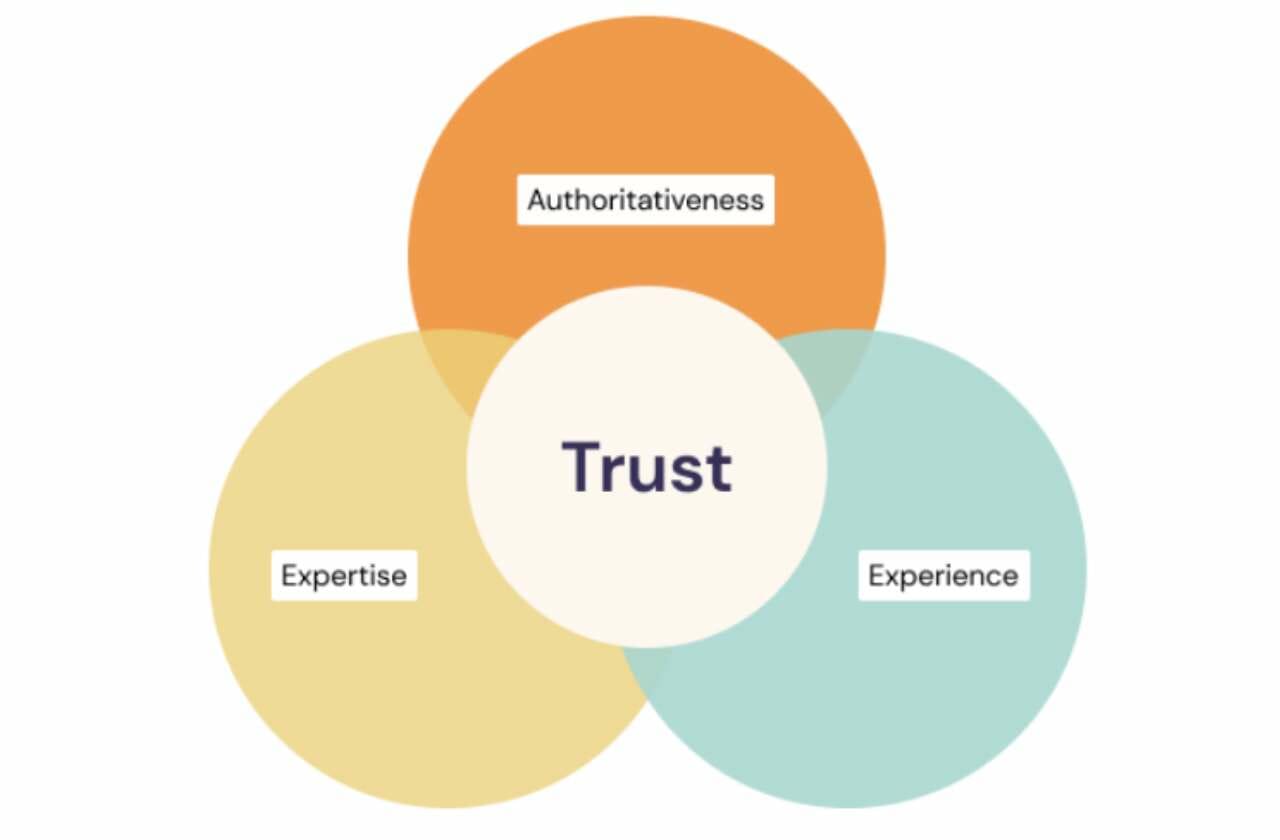
Using structured data on a web page can help search engines understand the E-E-A-T of content authors on a topic. How? Not directly, but it can help search engines recognize the data and relationships between the content creator, the website, and the main content to other entities around the world.
For example, we can use Author within a BlogPosting or Article schema class to specify name, age, nationality, occupation, education, relatives, company ownership, and many other attributes about the person who wrote the article. This allows search engines to recognize or create a new entity based on the information collected via structured data.
Linking Data With Schema.Org Person
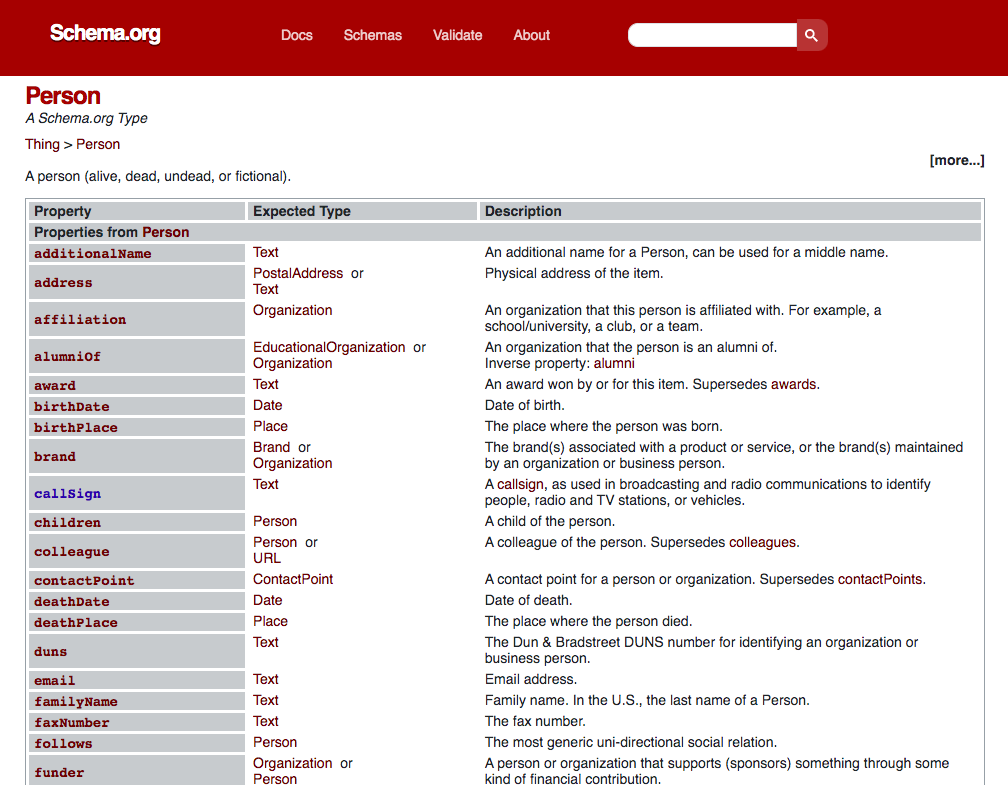
The above image is a snapshot from the official Schema.org website. It shows a type of structured data for a person. Many properties describe a person’s personal information and help search engines to capture this information and store it in their knowledge graph.
In addition, several properties establish a relationship between entities, e.g., the university where the person studied or the awards he won during his professional career. Let us dive into Person’s properties and use cases to understand the potential of linking data for E-E-A-T purposes.
alumniOf
The Schema.org property alumniOf describes the relationship between an individual and an academic institution from which they graduated. This property can be used to describe a person who has earned a bachelor’s, master’s, or doctoral degree, for example.
Usage example in JSON-LD:

The value of “alumniOf” is an object of type “CollegeOrUniversity” with a “name” property to indicate the name of the academic institution. A degree that is relevant to a particular subject increases a person’s authority.
award
The Schema.org property award describes an award or recognition received by a person or organization. It describes awards received for work, art, science, technology, culture, education, solidarity, etc. The award property is a property of the Person and Organization classes, and its value is a text string that describes the award or recognition received.

Information about awards and recognition you have received can be helpful for your personal branding because it shows your expertise and success in your field of work or interest. “award” can help you stand out from other professionals and demonstrate your experience and unique accomplishments.
hasOccupation
The Schema.org property hasOccupation describes a person’s current or previous occupation: a full-time job, a part-time job, self-employment, or a general career. The hasOccupation property is a property of the Person class, and its value is an Occupation class or a subclass of it.
Usage example in JSON-LD:

As for personal branding, the hasOccupation property can describe your current or past employment and help make your experience and skills known to potential clients, employers, or business partners. It can also help establish your reputation as an expert in your field and increase the visibility of your brand. HasOccupation can be used in conjunction with jobTitle.
memberOf
The Schema.org property memberOf describes the membership of a person or an organization in another organization or group. It describes membership in a professional association, club, non-profit organization, volunteer organization, alumni association, etc. The “memberOf” property is a property of the “Person” and “Organization” classes. Its value is a class “Organization” or a subclass of it.
Usage example in JSON-LD:

The “memberOf” property can be used to describe your memberships in organizations or groups, and to demonstrate your professional relationships and expertise. This can help establish your reputation as a professional and increase the visibility of your brand. For example, if you are a member of a professional association.
performerIn
The Schema.org property performerIn can be used to describe the participation of a person or organization as a performer in any type of event. It can describe a concert, a stage show, a movie, a TV show, a business event, etc. The “performerIn” property is a property of the “Person” and “Organization” classes and its value is an “Event” class or a subclass of it.
Usage example in JSON-LD:
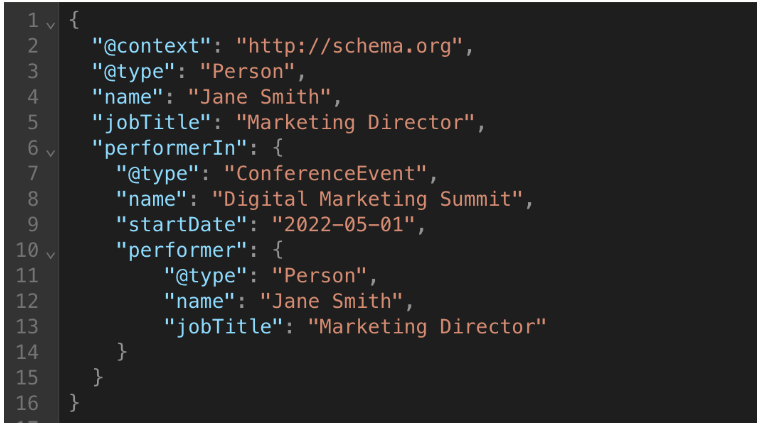
Content-Markup Consistency
It is crucial to maintain consistency between the on-page content and the structured data markup. Ideally, there should be less than a 5% discrepancy (according to Semantic SEO expert Jarno van Driel who has greatly study the relationship between structured data markup and E-E-A-T signals) between what’s visible to users and what’s present in the markup. The structured data should be a complete and accurate representation of the visible content.
This consistency helps build trust with both users and search engines. When the markup aligns closely with the visible content, it reinforces the authenticity of the information and improves the overall user experience. Search engines are more likely to trust and use the structured data when it consistently matches the on-page content.
To achieve this:
- Regularly audit your content and markup for consistency
- Update both simultaneously when making changes
- Ensure all key information visible to users is reflected in the markup
- Avoid including information in the markup that isn’t present in the visible content
Author Property For Personal Branding
The “author” property is one of the most important in determining the E-E-A-T of content. Because it allows you to associate the entity of the content with its author, you can add “author” to schema types within CreativeWork or Review, especially in Article, NewsArticle, MedicalScholarlyArticle, and TechArticle SD.
Usage example in JSON-LD:
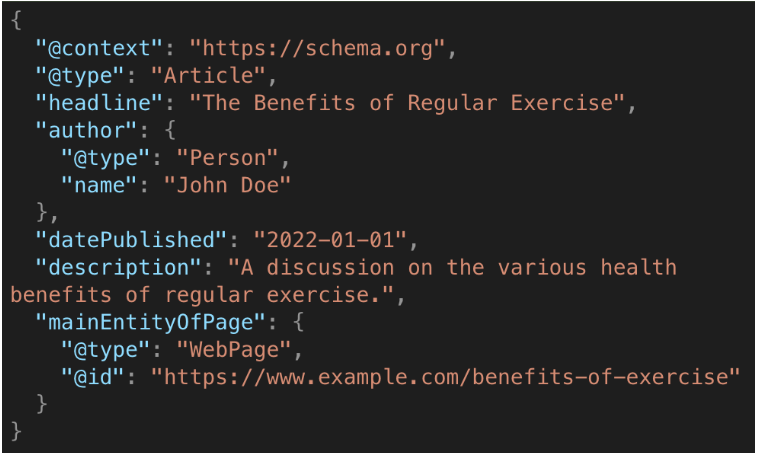
This property serves as valuable markup for the author line, providing both readers and search engines with information about the author of a particular piece of content. For Your Money or Your Life (YMYL) content, it becomes an important structured data markup that must be included in the page code to strengthen the trustworthiness of the content. YMYL refers to content that has the power to influence an important decision regarding a person’s money or life.
The last property we would like to introduce is the sameAs property. We have already written in our Academy about sameAs, one of the most valuable properties for linking data. SameAs indicates to search engines a unique relationship between a person and a specific page on another platform or website, such as a social network profile, a website profile, another author page, etc.
Dynamic Property Discovery
To enhance the completeness and accuracy of Person markup, we are experimenting with zero-shot Knowledge Graph creation methods. This approach aims to dynamically discover and include all relevant properties for a Person entity.
Zero-Shot Knowledge Graph Creation
A zero-shot Knowledge Graph is an intelligent, AI-driven system designed to build and expand knowledge graphs without requiring prior training on specific entities. It leverages agentic and neuro-symbolic approaches, combining autonomous agents with structured ontologies to understand, link, and enrich data in real time.
Key features of zero-shot Knowledge Graph creation include:
- Autonomous Learning: The system can understand and categorize new entities and relationships without pre-existing training data for those specific items.
- Neuro-Symbolic Integration: It combines neural networks’ pattern recognition capabilities with symbolic reasoning’s logical structure, allowing for more robust and interpretable knowledge representation.
- Real-Time Enrichment: The system can continuously update and expand the knowledge graph as it encounters new information, ensuring the graph remains current and comprehensive.
- Ontology Alignment: It can map discovered information to existing ontologies (like schema.org) automatically, ensuring consistency and interoperability.
- Context-Aware Relationship Inference: The system can infer relationships between entities based on context, even when those relationships are not explicitly stated.
The process of applying zero-shot Knowledge Graph creation to Person markup involves:
- Content Analysis: Using advanced NLP techniques to analyze the content related to the person, including text, images, and linked resources.
- Entity Recognition: Identifying and categorizing entities mentioned in the content, including the primary Person entity and related entities (organizations, events, locations, etc.).
- Property Inference: Inferring potential schema.org properties that apply to the Person entity based on the analyzed content and recognized entities.
- Relationship Mapping: Establishing relationships between the Person entity and other recognized entities, mapping these to appropriate schema.org properties.
- Confidence Scoring: Assigning confidence scores to inferred properties and relationships, allowing for prioritization of high-confidence information in the markup.
- Dynamic Markup Generation: Automatically generating structured data markup based on the discovered properties and relationships, prioritizing high-confidence information.
- Continuous Learning: Updating the knowledge graph and refining the inference process based on new information and feedback, improving accuracy over time.
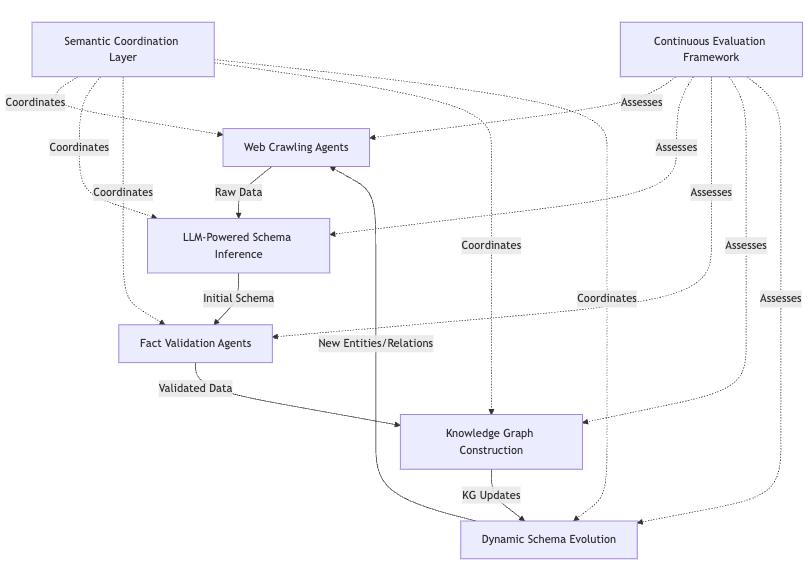
By employing zero-shot Knowledge Graph creation, we can generate more comprehensive and adaptable Person markup, capturing nuances that might be missed in a static approach. This method allows for:
- Discovery of less common but relevant schema.org properties that might be overlooked in manual markup creation.
- Automatic inclusion of emerging properties or relationships as the person’s career or achievements evolve.
- Consistency in markup across multiple pages or websites discussing the same person.
- Potential for discovering and representing complex relationships that might not be immediately apparent from the text alone.
While this approach offers significant advantages in terms of comprehensiveness and adaptability, it’s important to note that the generated markup should still be reviewed for accuracy and relevance. The system’s confidence scores can guide this review process, allowing human editors to focus on verifying high-impact or low-confidence properties.
The Evolving Nature of Person Entities
It’s important to note that this strategy is not a “set-it-and-forget-it” approach. A person’s digital footprint expands over time, their niche evolves, and Google’s dataset and algorithms continuously change. Regular monitoring and maintenance are crucial to maintain and improve the entity’s presence in Google’s Knowledge Graph.
By combining zero-shot Knowledge Graph creation with regular human oversight, we can create Person markup that is both comprehensive, up-to-date and accurate, significantly enhancing the entity’s representation in search results and knowledge graphs.
How You Can Add Structured Data To Your Content
We have seen all the structured data useful for personal branding, but how do we implement it on our website? Nothing easier than that with the WordLift tool. With a few clicks you can create structured data of all the types easily and intuitively.
WordLift also generates structured data useful for personal branding, such as Person (with sameAs), Articles and CreativeWork (with Author). WordLift’s strength lies in the technology behind it. Thank you to AI and machine learning, your website content is analyzed and understood. Once WordLift comprehend your content, you can structure the information by creating new pages as if they were entities of your knowledge graph.
This way, both search engines and users can understand the value of your content and, why not, of your personal brand.
Creating an “Entity Home”
As discussed in the embedded video by Jason Barnard, creating an “entity home” is crucial for effective personal branding and entity recognition. An entity home is a definitive, authoritative web page that serves as the primary source of information about a person or brand.
Key aspects of an effective entity home include:
- Comprehensive and up-to-date information about the person
- Clear, consistent structured data markup
- Links to official social media profiles and other authoritative sources
- Regular updates to reflect the latest information
- A clear, unique URL that’s easy to remember and associate with the person
The entity home serves as a central hub for search engines and users to find authoritative information about the person, enhancing their digital presence and authority.
Consistent AI-Friendly Description
Creating a consistent, easy-to-speak-aloud description of the person that fits the characteristics of a featured snippet or an AI Overview on Google is increasingly important. This description should be:
- Concise (typically 50-60 words)
- Factual and objective
- Highlight key aspects of the person’s identity, expertise, and achievements
- Use natural language that sounds good when spoken aloud
- Include key information that might be sought after in voice searches
Example:
“Sarah Chen is a renowned data scientist, AI researcher, and tech entrepreneur based in San Francisco. With over 15 years of experience, she has pioneered breakthrough algorithms in machine learning and founded two successful AI startups. As a queer woman in tech passionate about ethical AI, cybersecurity, and marine conservation, Sarah brings a unique perspective to her work, frequently speaking at global tech conferences and advising Fortune 500 companies on AI strategy.”
Google’s Recognition of Content Creators
Recent developments have shown that Google is now explicitly identifying people it understands to be content creators. This is a significant breakthrough for E-E-A-T and SEO strategies as highlighted by Jason Barnard on his latest analysis for Search Engine Land on Person entities in Google’s Graph.
Knowledge Panel Subtitles
Google has introduced Knowledge Panel subtitles like “Content Creator (Medicine)” and “Content Creator (Travel)” in the SERPs. This demonstrates Google’s explicit identification of individuals as authoritative content creators within specific fields.
What Featured Snippet You Can Get Using Structured Data
By providing all the information and details we have previously seen, Google and search engines know exactly what users can find on your site – and what it all means. This allows them to present your content in search results in an eye-catching and visual way.
Here we show you 2 important features in the SERPs that you can get for your personal branding with structured data in your content.
Google Answer Box
In the Google SERP, we can see the attribute value of an entity when we search for specific information. “How old is Barack Obama?”, “How tall is LeBron James?”, “Where was J.K. Roling born?”, etc. Search engines like Google can respond directly to these types of queries.

This SERP snippet is called Google Answer Box and takes data directly from the knowledge graph! An entity in the knowledge graphs can contain attributes that come from structured data and other sources.
Google Knowledge Panel
The knowledge panel is the ‘rich result’ that summarizes the most important information about a particular entity or topic.
Appearing in Google’s Knowledge Panel is a great opportunity for you and your business. It allows you to gain more visibility and reach more people, which increases traffic and conversions on your website.
Adding structured data to your content allows Google to have consistent and complete information about you and provide users with these types of results when they search for your name.
We asked Jason Barnard, the Brand SERP Guy, to show us how to set up WordLift to enable a Knowledge Panel. Watch the video and start using structured data for your personal branding now!
Action Points for the “Perfect Person Markup“
- Focus on building an understanding of person-to-page relationships (consider these as linkless links).
- Apply this strategy to content creators on your (or your clients’) websites.
- Aim to enhance rankings, increase SERP visibility, and improve knowledge-based results such as Knowledge Panels, entity lists, and AI Overviews.
- Invest on building your own Knowledge Graph to be able to keep information fresh and up-to-date.
By incorporating these insights into your structured data and SEO strategy, you can better position content creators for recognition by Google and other AI-powered search and assistive engines, ultimately improving visibility and authority in search results.